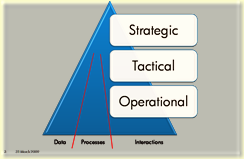We're all being told to stop traveling. However, in our international or global roles, we are all supposed to continue collaboration within the enterprise and across the eco-system. obviously, our performance is supposed to be at least as good as what it used to be, however we are not been given any tools or hints on how to do this virtually. Isn't that strange?
I had the opportunity to meet a number of industry analysts last week and asked them the question if they saw research in that space. And frankly, with a very small number of exception, the overwhelming response was NO. I believe there is a great opportunity here to innovate and contribute to the companies need to reduce costs and greenhouse gas emissions, while motivating employees and improve efficiency.
The answer in my mind is not ONE tool, as the collaboration needs are from a variety of types.  In the attached drawing I tried to illustrate my idea. Let me walk you through this by taking a couple examples from a supply chain.
In the attached drawing I tried to illustrate my idea. Let me walk you through this by taking a couple examples from a supply chain.
- If you work collaboratively with a supplier and he sees that one of the trucks will arrive late, he can easily make you aware of this through the use of an instant messaging software. A couple of interactions are enough to point out what the issue is, how much delay it will cause and how certain you can be of the new timing. This interactive conversation will obviously be complemented by data that is automatically transferred between partners (e.g. Shipment Notification), and business processes that are executed (e.g. Call-Off process).
- If, when receiving the new revision of the forecast, the supplier realizes he is unable to deliver, but has another proposal on how things could be done, he may want to have a more personal interaction with the planner. He can call him up, using regular lines or VoIP, eventually complemented with PC based video, to discuss the situation, his proposal and come up with an agreement on how to move forward. This interaction is obviously followed up by a transfer of data and the execution of a forecast revision process, and its acceptance.
- If the customer is planning to introduce a brand new product, that implies a different approach in the supply chain, he will probably not want to discuss this over the phone or instant messaging. He will probably be interested in looking at his supplier eye to eye. Video conferencing, and telepresence are ways to achieve this. The interaction is different as it needs a different way to view and understand the attitude of the other.
- If the customer wants ideas being generated by his own or suppliers employees, he will probably use another mechanism. Today a number of "innovation storm" techniques exist. But here again, they address a specific purpose.
These are just examples, but they illustrate the variety of technologies that are required and the different skills that are required to interact with each other. It used to be so simple just to drive or fly to a common location, discuss things face to face and end in the bar,.... where a lot of issues were washed away with a couple pints. Haven't found any techniques to address that one unfortunately.
